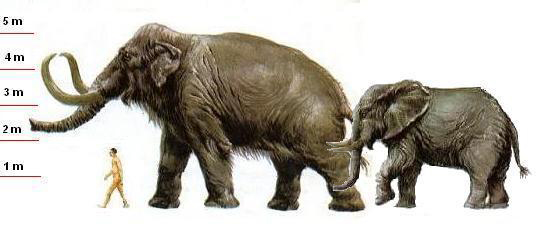|
| 질의: japanese gregory | 결과: 3번째/3 | |
Songhua River Mammoth (Mammuthus sungari) - Wiki
| 제목: | Songhua River Mammoth (Mammuthus sungari) - Wiki
| |

| 해상도: 542x226
파일크기: 53703 Bytes
등록시간: 2008:01:14 13:08:37
|
Mammuthus sungari
From Wikipedia, the free encyclopedia
Order: Proboscidea
Family: Elephantidae
[Photo] Comparison of the Songhua River Mammoth with the smaller African Elephant. Author: Asiertxo. URL: http://en.wikipedia.org/wiki/Image:Mammuthus-sungari.jpg | Permission is granted to copy, distribute and/or modify this document under the terms of the GNU Free Documentation License, Version 1.2 or any later version published by the Free Software Foundation; with no Invariant Sections, no Front-Cover Texts, and no Back-Cover Texts. A copy of the license is included in the section entitled "GNU Free Documentation License". |
According to the Ibaraki Nature museum, the Songhua River Mammoth -- also known as the Shokako Mammoth in Japanese -- (Mammuthus sungari) was the largest mammoth in the world, surpassing even the Imperial Mammoth in size. The mounted skeleton at the museum reaches an overall height of 5.3 meters and a length of 9.1 meters, with hips more than 2.2 meters wide and tusks 3.2 meters in length. This specimen could have weighed more than 17 metric tons, as heavy as Paraceratherium, making it one of the largest land mammals of all time.
The Songhua River Mammoth lived in Northern China during the Late Pleistocene about 100,000 to 10,000 years ago. Its remains have been found in the Gobi Desert.
Size
Asier Larramendi and P??rez Molina estimated that a Songhua River Mammoth 4.7 meters high at the shoulders would have weighed more than 17 metric tons, or nearly three times heavier than the modern African elephant.
Method of estimation
To calculate the mammoth's weight, Asier Larramendi created a technique (based on Gregory Paul´s drawings) that consisted of separating the animal into different parts and modeling those parts as cylinders. The volumes of these cylinders can then be calculated and multiplied by the typical density of mammals. To demonstrate the accuracy of the technique, the approach was applied to an African elephant 3.5 meters high. The estimated weight for this animal was found to be 6.4 metric tons, which is consistent with the actual weight of an elephant of that height.
Comparison to other large mammals
Larramendi applied his model to a 4.5 meters tall Mammuthus trogontherii, getting the result of 12 metric tons. The much smaller figure owes to the fact that M.sungari was nearly a third wider than M.trogontherii.
Larramendi then applied the same approach to estimate the mass of the largest Indricotherium found, which was 5.4 meters to the shoulders. The Indricotherium was estimated to weigh 16.8 metric tons, about a half ton less than the M.sungari, due to its more slender frame. If accurate, this would imply that M.sungari was the largest land mammal known to have lived.
Paleontologist Gregory Paul has estimated that the largest Indricotherium remains found (two giant vertebrae and a partial central metacarpal) suggest the a height at the shoulders of 4.8 meters. Nevertheless, Paul estimated the mass of the Indricotherium at over 16 metric tons. Larramendi's approach would result in the lower estimate of 14.5 metric tons for this animal. For the mammoths' calculations there would be significant differences as well; Paul estimated a 4.0 meters M.Trogontherii would weigh 11 metric tons, while Larramendi estimated 9 metric tons.
http://en.wikipedia.org/wiki/Mammuthus_sungari
| The text in this page is based on the copyrighted Wikipedia article shown in above URL. It is used under the GNU Free Documentation License. You may redistribute it, verbatim or modified, providing that you comply with the terms of the GFDL. |
|
댓글 |
|---|
| | cialis |
|
| I8pcJk dqahqqeh zeusgtnw hrfwjsqi |
^o^
동물그림창고 똑똑전화 누리집
^o^
|
|
|